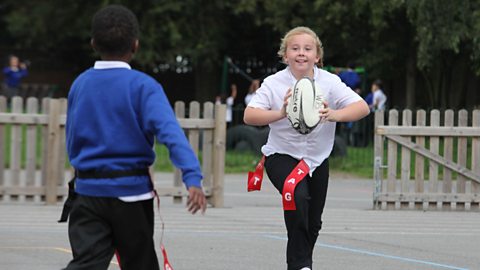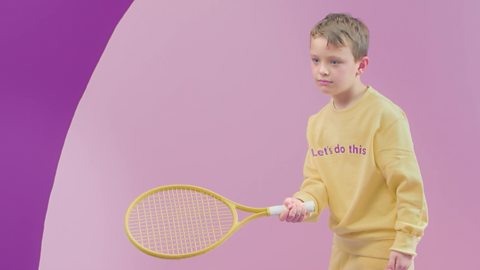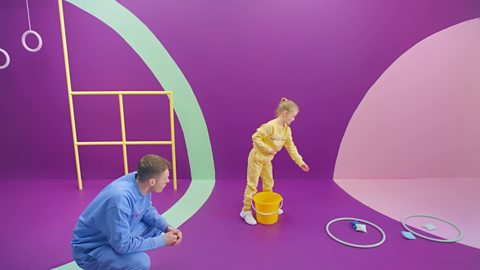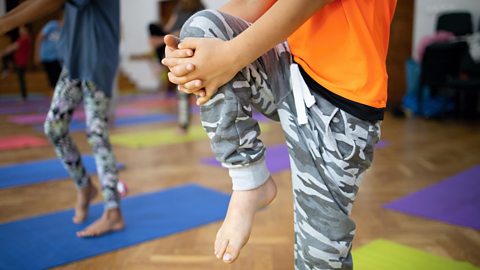Let's get active and try Scatter!
With the Scatter activity you can develop the following skills:
- Coordination and fluency
- Speed and agility
- Flexibility
This resource is suitable for Physical Education and activity for P2, P3, P4, P5, P6 and P7 (First and Second Level Curriculum for Excellence).
Watch this
Learn how to take part in the Scatter activity with help from primary school teacher, Danny Denholm and wheelchair athlete, Gemma Lumsdaine.
DANNY: Hey, I'm Danny. And welcome to Let's Do This, where we will get active together.
This activity is called Scatter. This game is great for developing your speed and agility. This means we are going to be thinking about moving quickly and with balance.
You will need balls or socks, a bucket or a hoop.
I've got wheelchair rugby athlete, Gemma here to help show you.
GEMMA: Hello!
DANNY: Step one, scatter several balls or socks or whatever you can get your hands on all around the playing area.
Step two, the aim here is to collect all the items and place them back into a bucket as quickly as possible.
Let's do this!
It's like when my mum asks me to clean my room.
NARRATOR: Too tough?
DANNY: Try scattering the balls closer together or in a smaller area.
GEMMA: If you want, you can try using two buckets to collect. These can be put in two different places so you don't have to move so far making it easier.
NARRATOR: Go up a notch?
DANNY: If you are feeling really ambitious add more balls and scatter them further apart.
NARRATOR: Gemma's challenge.
GEMMA: For my challenge, try to get quicker each time you do the task.
Can you beat yourself? Could you pick up the socks in 30 seconds?
NARRATOR: Final thoughts.
DANNY: This is a great activity if you like moving around a lot. Why not try this again by putting dirty clothes in the washing basket?
Let's do this!
What you need
| Equipment | Alternatives |
|---|---|
| 20 balls | Any small items that are easy to collect and tidy away, like balled-up socks or soft toys |
| Bucket | Any item that you can collect items in, like a hoop or box |
Try it yourself
Follow these step-by-step instructions and give it a go!

Image caption, Scatter
Scatter around 20 balls or similar items in a small area.
Image caption, Collect a ball
Pick up one of the balls and place it in the bucket
Image caption, Repeat
Repeat until you’ve picked up all the balls.
1 of 3
Want to play with a friend?
- Divide the playing area in half to create two zones.
- Instead of putting your items into a bucket, drop them into your opponent's zone.
- Time yourselves for either 30 seconds or a minute.
- At the end of the time, the player with the fewest items in their zone is the winner.
How was Scatter for you?
We are all unique and have different strengths and skills. Some of us may find some skills easier than others but we can all develop and improve.
You can adapt the Scatter activity to suit your needs. If we practise our skills regularly, we can improve and progress over time.
Too tough?
If you find Scatter too challenging, don't worry!
Try these tips to make the activity a bit easier.
- Scatter the balls closer together or in a smaller area.
- Try using two buckets to collect. They can be placed in two areas so you don’t have to move as far.
Go up a notch?
It's great to look at ways to develop our skills and we can do this by challenging ourselves.
If you enjoyed Scatter but are looking for a bigger challenge, try these tips to make it trickier.
- Add more balls.
- Scatter the balls even further apart.
Gemma's challenge
Time yourself when completing the Scatter challenge and try to get a better time each time you do the task. Can you beat your personal bestThe best time or score someone has achieved in a particular sport or event.?
You could even set yourself a specific target. For example, can you pick all the balls (or other items) in 30 seconds?
Time to reflect
Enjoyment
The most important part of physical activity and movement is that you enjoy it. We all need to stay active in our daily lives in order to stay healthy. It’s a lot easier if you’re having fun.
After you’ve taken part in this activity, take some time to think about what you enjoyed and how you might approach the activity differently next time.
- What did you enjoy about this activity? How could you do more of this?
- What did you dislike about this activity? What would make it better?
- What would you do differently next time?
Developing your skills
The skills you’ve worked on in this activity are useful in other parts of your daily life and in sport.
Can you think of any activities or sports where you might use these skills?
The skills you've developed in this activity could help with:
- tidying up in class or at home
- chasing after someone during games
Physical activity skills. listPhysical activity skills
Learn more about the different skills you've developed in this activity and how we use them in daily life.

More on Physical activity
Find out more by working through a topic
- count7 of 18

- count8 of 18

- count9 of 18

- count10 of 18

